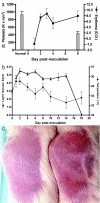Dengue fever in humanized NOD/SCID mice
- PMID: 16227299
- PMCID: PMC1262615
- DOI: 10.1128/JVI.79.21.13797-13799.2005
Dengue fever in humanized NOD/SCID mice
Abstract
The increased transmission and geographic spread of dengue fever (DF) and its more severe presentation, dengue hemorrhagic fever (DHF), make it the most important mosquito-borne viral disease of humans (50 to 100 million infections/year) (World Health Organization, Fact sheet 117, 2002). There are no vaccines or treatment for DF or DHF because there are no animal or other models of human disease; even higher primates do not show symptoms after infection (W. F. Scherer, P. K. Russell, L. Rosen, J. Casals, and R. W. Dickerman, Am. J. Trop. Med. Hyg. 27:590-599, 1978). We demonstrate that nonobese diabetic/severely compromised immunodeficient (NOD/SCID) mice xenografted with human CD34+ cells develop clinical signs of DF as in humans (fever, rash, and thrombocytopenia), when infected in a manner mimicking mosquito transmission (dose and mode). These results suggest this is a valuable model with which to study pathogenesis and test antidengue products.
Figures


References
-
- An, J., J. Kimura-Kuroda, Y. Hirabayashi, and K. Yasui. 1999. Development of a novel mouse model for dengue virus infection. Virology 263:70-77. - PubMed
-
- Blaney, J. E., Jr., C. T. Hanson, K. A. Hanley, B. R. Murphy, and S. S. Whitehead. 4. October 2004, posting date. Vaccine candidates derived from a novel infectious cDNA clone of an American genotype dengue virus type 2. BMC Infect. Dis. 4:39. [Online.] doi:10.1186/1471-2334-4-39. - DOI - PMC - PubMed
-
- Cravens, P. D., M. W. Melkus, A. Padgett-Thomas, M. Islas-Ohlmayer, M. del P. Martin, and J. V. Garcia. 2005. Development and activation of human dendritic cells in vivo in a xenograft model of human hematopoiesis. Stem Cells 23:264-278. - PubMed
-
- Halstead, S. B., and J. Deen. 2002. The future of dengue vaccines. Lancet 360:1243-1245. - PubMed
Publication types
MeSH terms
Substances
Grants and funding
LinkOut - more resources
Full Text Sources
Other Literature Sources
Medical
Miscellaneous

